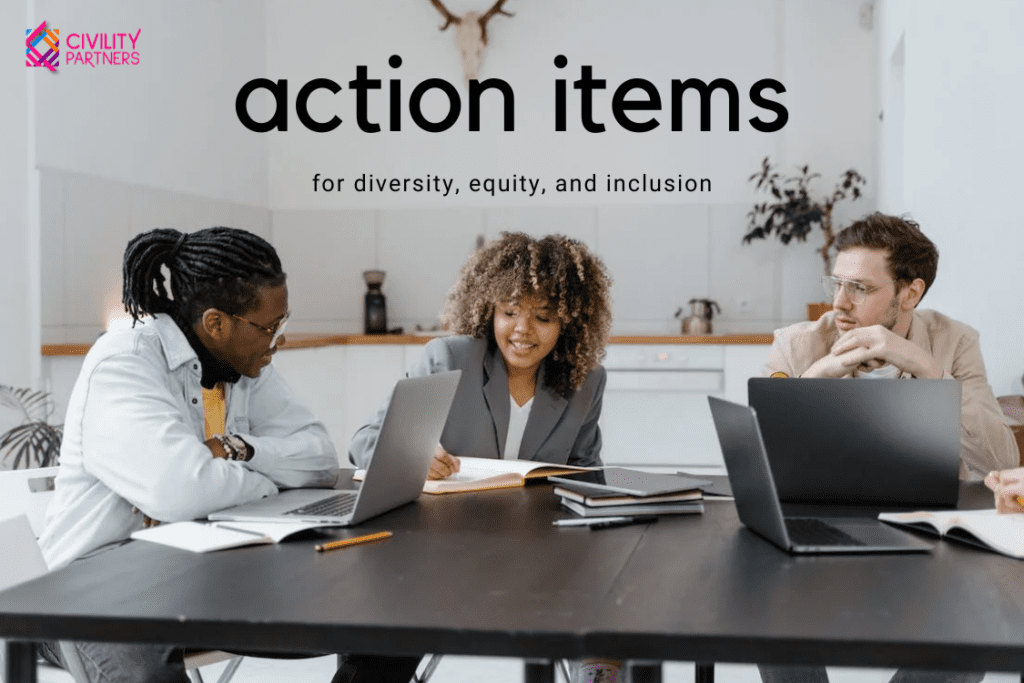Building a healthy workplace where employees feel appreciated and respected requires, among other things, making it diverse and inclusive. It is essential for organizations that want to attract and retain top talent, foster innovation, and stay competitive in today’s global economy.
Diversity has been a buzz word for a number of years, and after unsuccessfully recruiting, hiring and onboarding expensive diverse talent just to lose them after 3-6 months of employment – many companies are reconsidering their action items for DEI.
As consultants and learning & development professionals focused on building positive work cultures, we compiled an action plan for organizations looking to improve their diversity efforts.
Assess your current state
Start by conducting an audit of your current workforce policies or practices that may be contributing to a lack of diversity. Your audit should include your company’s:
- Workforce demographics
- Recruitment & hiring practices
- Promotion & advancement
- Retention data
In addition, run a climate assessment (i.e., an employee survey) that gauges how your workforce is feeling not just about diversity but inclusion, equity and belonging. A climate assessment measures a variety of constructs, including employee engagement, job satisfaction, internal communication, and more.
You might learn that one underrepresented group feels differently about these areas than the rest of the workforce, or that many people have all witnessed some level of discrimination or harassment among their peers but are not sure how to bring it up to the management.
Both of these tools are powerful ways to stay on top of DEIB, as long as you’re sure to make required adjustments, these assessments should be conducted on a regular basis.
Set SMART goals
Based on your assessment results, create SMART (Specific, Measurable, Achievable, Relevant, and Time-bound) goals for increasing not just diversity, but inclusion of your diverse talent across your organization. This will make it easier for your company to monitor its success and track its progress.
So, identify the metrics that are important to track. Obviously, better survey scores the next time around us one version of that, but what business results do you seek? Other metrics might include a 25% increase in diversity in your candidate pool, or being recognized in your community as a leader in DEIB.
Beyond being able to measure your success, metrics allow you to create specific objectives and KPIs, so that everyone working for your organization is focused on the same goals and is aware of their part in attaining them. This is what creates inclusion – working on a project all together as a company.
To be honest, this is one place we see a lot of companies waste their efforts and budget, and actually create more damage than good. We always recommend the help of experts in all of your DEIB initiatives.
Train employees
Provide training for all of your employees on topics like unconscious bias, intercultural communication, and how to create a more inclusive work environment. We always offer a two part training, so that everyone gains the interpersonal skills needed to build inclusivity, and then people leaders gain specific tools to run more inclusive meetings, coach those engaging in damaging behavior, and proactively build a positive team culture.
We, at Civility Partners, pride ourselves on developing custom training that fits your organization’s needs!
Lead by example
Leaders play a crucial role in setting the tone and culture of an organization. Encourage leaders to model inclusive behavior that welcomes and respects differences.
In fact, we created an inclusivity performance matrix for one of our clients, so that they could measure leaders on their inclusive behavior skills. It included the following topics, and behavioral competencies were provided for all six:
- Demonstrates respect for people and their differences
- Promotes the benefits of a diverse workforce
- Is trusted and respected by others
- Includes and welcomes others
- Works to understand the perspectives of others
- Promotes opportunities to experience diversity on campus
If managers and leaders are inclusive, your diverse workforce will want to stay.
Be accountable
Hold the organization responsible for attaining its diversity goals by tracking progress. It aids in ensuring that the company adopts a long-term strategy for diversity and inclusion and integrates it into its culture. Celebrate accomplishments, take lessons from setbacks, and keep becoming better!
Diversity in the workplace is an ongoing process that requires the commitment and efforts of everyone. By adhering to your action plan, organizations can make efforts toward developing a more diverse and inclusive workplace that benefits everyone.
Sincerely,
Anya, Catherine, Jenny + the Civility Partners Team
PS – Catherine’s LinkedIn Course, Strategic Human Resources, is featured in LinkedIn’s list of the 2023 Jobs on the Rise to support jobseekers in navigating the uncertain economic climate! It’s free until the 25th!
If you don’t have a LinkedIn Learning account yet, you can start your 30-day free trial here.



